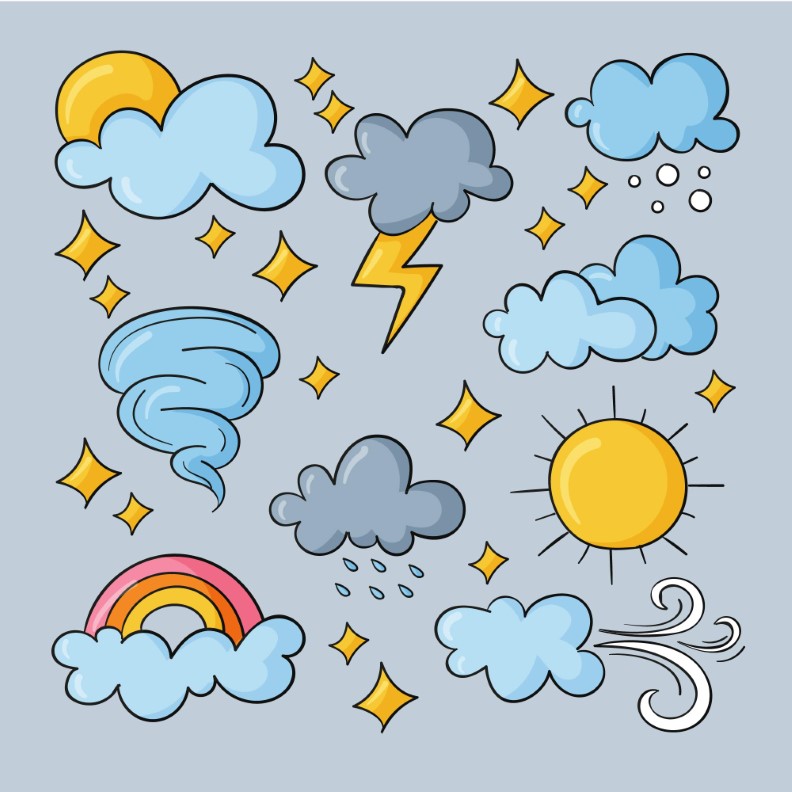
Discussing the Weather:
Vocabulary related to weather:
The topic “Discussing the Weather” focuses on learning how to talk and express ideas about the weather in English. Weather is a common topic of conversation in everyday life, and it is important to be able to express and understand weather conditions in different situations. Below are key points to keep in mind when discussing weather.
Express the current conditions:
- You can use simple phrases to describe the weather in any moment, for example:
- "It's sunny today." (Hoy está soleado).
- "It's raining heavily." (Está lloviendo fuertemente).
- "It's cloudy with a chance of showers." (Está nublado con posibilidad de lluvias).
Talk about the weather forecast:
Some expressions to talk about the weather forecast:
"They predict rain tomorrow." (Pronostican lluvia para mañana).
"The forecast says it will be hot this weekend." (El pronóstico indica que hará calor este fin de semana).
"There's a chance of thunderstorms in the evening." (Hay posibilidad de tormentas eléctricas por la tarde)
Vocabulary
| 🔊 | Weather | The state of the atmosphere, including temperature, wind, precipitation, autumn/fall, spring, summer, winteretc. |
| 🔊 | Sunny | Having a lot of sunshine; no clouds in the sky. |
| 🔊 | Cloudy | Covered with clouds; lacking sunshine. |
| 🔊 | Rainy | Characterized by rainfall; wet weather with rain. |
| 🔊 | Windy | Having a lot of wind; breezy conditions. |
| 🔊 | Hot | Having a high temperature; opposite of cold. |
| 🔊 | Cold | Having a low temperature; opposite of hot. |
| 🔊 | Warm | Moderately high temperature; pleasant and comfortable. |
| 🔊 | Cool | Moderately low temperature; not warm or hot. |
| 🔊 | Humid | Having a high level of moisture or humidity in the air. |
| 🔊 | Dry | Lacking moisture; not humid or wet. |
| 🔊 | Snowy | Characterized by snowfall; covered in snow. |
| 🔊 | Foggy | Covered in thick fog; visibility reduced. |
| 🔊 | Stormy | Characterized by storms; turbulent and often with heavy rainfall. |
| 🔊 | Thunderstorm | A storm with thunder, lightning, and usually heavy rain. |
| 🔊 | Lightning | The occurrence of a natural electrical discharge in the atmosphere, often accompanied by thunder. |
| 🔊 | Hail | Precipitation in the form of small, hard pellets of ice. |
| 🔊 | Forecast | A prediction or estimation of future weather conditions. |
| 🔊 | Climate | The prevailing weather conditions in a particular area over a long period of time. |
| 🔊 | Temperature | The degree of hotness or coldness of the atmosphere. |
| 🔊 | Season | A division of the year characterized by specific weather patterns and daylight hours (e.g., summer, winter). |
| 🔊 | Umbrella | A portable device used to protect against rain or sunlight. |
| 🔊 | Jacket | A lightweight, often zippered outer garment worn to protect against cool weather. |
| 🔊 | Sweater | A knitted garment typically made of wool or cotton, worn to provide warmth. |
| 🔊 | Windbreaker | A lightweight jacket designed to protect against wind. |
| 🔊 | Heatwave | A prolonged period of excessively hot weather. |
| 🔊 | Frost | A thin layer of ice that forms on surfaces when the temperature drops below freezing. |
| 🔊 | Drought | A prolonged period of abnormally low rainfall, resulting in a water shortage. |
| 🔊 | Breeze | A gentle wind or light current of air. |
| 🔊 | Muggy | Hot and humid; uncomfortably warm and damp. |
Activity
Title: "Weather Wonders"
One of the most common weather conditions is rain. Rain occurs when water droplets fall from clouds and reach the ground. It can range from a light drizzle to a heavy downpour. Rain is vital for the growth of plants and crops and helps replenish our water sources.
Snow is another enchanting weather event, especially in regions with cold winters. When the temperature drops below freezing, water vapor in the air crystallizes into snowflakes, forming a soft blanket of white on the ground. Snow can be a delight for children, who enjoy building snowmen and engaging in snowball fights.
On the other hand, extreme weather events can be more challenging to deal with. Hurricanes, tornadoes, and cyclones are powerful and destructive storms that can cause extensive damage to homes and communities. Being prepared for such events is crucial to ensure safety and minimize their impact.
Reading Comprehension Questions:
What does the term "weather" refer to?
- a) The conditions in outer space
- b) The atmospheric conditions in a specific area
- c) The movement of celestial bodies
.
How does rain occur?
- a) Water droplets fall from clouds to the ground.
- b) Water droplets rise from the ground to form clouds.
- c) Water droplets evaporate into the atmosphere.
.
What is the significance of rain?
- a) It helps water the plants and crops.
- b) It causes damage to homes and communities.
- c) It creates snow during winter.
.
How is snow formed?
- a) Water droplets crystallize into snowflakes in warm temperatures.
- b) Water droplets fall from clouds and freeze on the ground.
- c) Water vapor in the air crystallizes into snowflakes in freezing temperatures.
.
What can extreme weather events like hurricanes and tornadoes cause?
- a) Extensive damage to homes and communities
- b) Growth of plants and crops
- c) Delight for children with snow activities
.
Why is being prepared for extreme weather events important?
- a) To create an enchanting atmosphere
- b) To ensure safety and minimize their impact
- c) To enjoy outdoor snow activities
.
Activity 2